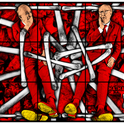Just as good drama sends you out refreshed and lighter in spirit, so you leave the scene of theatrical dross feeling flat; it is as if you had witnessed an atrocity whose victims (including yourself) cannot be helped.
A bad production of a bad play produces a special resentment: it is an evening of your life, stolen by the thieves. Such gloom is redoubled when you know the company-in this case, Manchester's Royal Exchange-is capable of wonderful work. In light comedy and fin de si?cle farce, Braham Murray and his colleagues can be peerless; they even managed to make, if not a silk purse, at least a nylon bumbag out of a sow's ear like Look Back in Anger. Their classics tend to be marred by failures in acting technique, for example shouting of verse and modern body language in period costume; but this is down to the new instant-fame generation of actors, indifferent to classical skills which need years to build up and polish.
But there is no excuse for Manchester's current disaster: Misfits. This crime against dramaturgy was committed by an American woman, Alex Finlayson-a product of the Mobil International play competition. After her first Royal Exchange production, Winding the Ball, she was given a generous bursary to write another play. Inspired by Eve Arnold's photographs of the crew, author and cast of Arthur Miller's film The Misfits, Finlayson laboured for 24 months. Misfits is the result.
The best plays, the best photographs are not just true; they are a dramatisation of the truth. As her current exhibition at the Barbican makes clear, Eve Arnold is one of the finest living photodramatists. Spanning four decades, her subjects range from immigrant potato pickers in the US to Arab women in the middle east, to Harlem, to a blizzard of subjects in between, including Marilyn Monroe and The Misfits.
Eve Arnold's approach to her subjects, like that of any good artist, seems to move from the inside out to catch or create the image. Finlayson, on the other hand, lunges from the outside at. She has assembled a collection of awkwardly written scenes, which take place during the production of Arthur Miller's film directed by John Huston. The central character is Marilyn Monroe who endures loneliness, uncertainty, and a sort of aesthetic angst-exacerbated by the brutal insensitivity of Miller and Huston.
Since the latter two parts are written and performed at the level of a Punch and Judy show, it is hard to respond to either without a chuckle of disbelief. Marilyn Monroe (Lisa Eichhorn's best cannot save this role) is written with the subtlety of a meat cleaver. One scene is peculiarly graceless, in a way I suspect the writer and her director Greg Hersov did not intend. Alone with her husband in the bedroom, Marilyn strips naked to manipulate Miller with sex, but achieves no more than what looks like a joyless fuck. There is no trace of any believable relationship between them.
John Huston strolls on sporadically, bawling like some Damon Runyon caricature of a capo mafioso in a safari suit. Stephen Yardley makes no effort to relate character, voice, or anything else to Huston. Finlayson apparently researched the background to her play, but had no idea of what shape to give it. Barring one good scene in which homosexual Montgomery Clift (a sensitive performance by James Clyde) tries to comfort Marilyn, the writer gives us a sketchy mix of thinly realised personae, trapesing here and there and signifying not a lot.
Mistaking loud noise for emotion, Hersov makes them shout at each other. Technicians appear, make mildly funny remarks, and vanish. John Huston barks and loses money in Las Vegas. Eli Wallach plays the fool. Marilyn's mentor, Paula Strasberg, waffles pretentiously. Marilyn is late for shooting, Marilyn takes an overdose, Clark Gable and Montgomery Clift are nice to her, but Marilyn remains a pain, a spoiled actress whose talent is no excuse for abominable behaviour.
But so what? Even if the piece was cogent and dramatic, nothing of any value is at stake. There is no sense of how a film production works or moves forward, and Finlayson has been unwise enough to restage the one scene from The Misfits which exposes the bathetic core of the film itself: Marilyn bends double in the desert and screams an accusation of murder at her friends/ lovers who are about to kill some wild horses.
After two and a half hours the play tails off into nothing. Maybe it is a failed attempt to create one more in the line of works that hold Marilyn Monroe up as a wounded innocent who perished tragically. In fact she was a self-created, mercilessly manipulative star who voluntarily entered a vicious and artificial business. She did not have what it took to survive on her own terms in that environment. Her squalid, banal death was sad, but not profoundly significant. Perhaps it is time to let the poor woman rest in peace.
Missed fit
Herb Greer is depressed by a play about the making of the Marilyn Monroe film "The Misfits." It is time to let the poor woman rest in peace foundations remain uncertain. Ernest Gellner unravels the flaws in the work of Isaiah Berlin, the champion of modern liberalism
June 19, 1996












